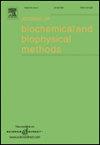Quantification of penicillin G during labor and delivery by capillary electrophoresis
Abstract
In this study, a capillary electrophoresis (CE) method was developed as a means to measure levels of penicillin G (PCN G) in Group B Streptococcus (GBS) positive pregnant women during labor and delivery. Volunteers for this developmental study were administered five million units of PCN G at the onset of labor. Urine, blood, and amniotic fluid samples were collected during labor and post delivery. Samples were semi-purified by solid-phase extraction (SPE) using Waters tC18 SepPak 3 cc cartridges with a sodium phosphate/methanol step gradient for elution. Capillary electrophoresis or reversed-phase high-performance liquid chromatography (RP-HPLC) with diode-array absorbance detection were used to separate the samples in less than 30 min. Quantification was accomplished by establishing a calibration curve with a linear dynamic range. The tC18 SPE methodology provided substantial sample clean-up with high recovery yields of PCN G (∼ 90%). It was found that SPE was critical for maintaining the integrity of the separation column when using RP-HPLC, but was not necessary for sample analysis by CE where no stationary phase is present. Quantification results ranged from millimolar concentrations of PCN G in maternal urine to micromolar concentrations in amniotic fluid. Serum and cord blood levels of PCN G were below quantification limits, which is likely due to the prolonged delay in sample collection after antibiotic administration. These results show that CE can serve as a simple and effective means to characterize the pharmacokinetic distribution of PCN G from mother to unborn fetus during labor and delivery. It is anticipated that similar methodologies have the potential to provide a quick, simple, and cost-effective means of monitoring the clinical efficacy of PCN G and other drugs during pregnancy.

 求助内容:
求助内容: 应助结果提醒方式:
应助结果提醒方式:


